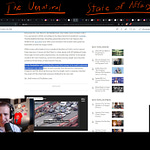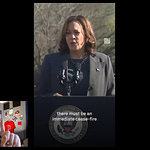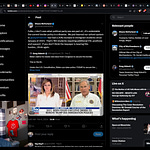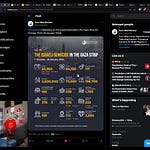Hey Friend,
The Unnatural State of Affairs persists. So, I’ll be barkin’ about…
Gaza Updates
New Stats from the Euro-Med Human Rights Monitor
Israel Strikes Iranian Embassy in Turkey
WHO’S READY FOR WW3??
More Virtue Signaling from the Biden Administration
The Vote “Uncommitted” Movement Continues
…so does the Vanderbilt
Administration’sRegime’s Suppression of its Students
The Relevance of Manufacturing Consent in the Digital Era
This is a paper I wrote for my History and Theory of Rhetoric class about Manufacturing Consent. It has a lot to do with a segment from my last show on the role of objectivity in news media.
The Unnatural State of Affairs broadcasts live on WMTS 88.3 FM, every Friday at 4-6 P.M.
Tune in to hear the censored talk show segments and DJ session!
Copy of “The Relevance of Manufacturing Consent in the Digital Era”
On July 11, 2019, Fox News published an opinion piece from Tennessee Congressional Representative Mark Green, titled “Rep. Mark Green: I'm an ER doctor, here's why socialized medicine would be a total disaster for America.” Anyone with a sliver of capacity for critical thinking skills would immediately laugh at it. Rep. Green, a former doctor, begins his magnum opus bragging about his experience as “an emergency room physician, a cancer survivor…and founder of a healthcare company” (2019), and uses that experience to justify “that socialized medicine will be a total disaster” (2019). He is using the term “socialized medicine” to refer to Medicare-for-All, a national healthcare plan that would enact a single-payer healthcare system (El-Sayed & Johnson, 2021, p. 100). Only two paragraphs in, Rep. Green stoops to regurgitating the misinformation commonly associated with Fox News, as Medicare-for-All is not “socialized medicine” (2019). A socialized medicine system would feature direct government ownership of hospitals and clinics, while Medicare-for-All simply establishes a system that reimburses private healthcare facilities with public funds (El-Sayed & Johnson, 2021, p. 100). Of course, Rep. Green would not care about this distinction, as his objective is to convince Fox News’ conservative audience (Jurkowitz et al., 2020) that he shares their beliefs, not to adequately inform them about healthcare proposals. Naturally, then, after a two-paragraph pat-on-the-back for his treatment of a woman dealing with urgent complications from her chemotherapy treatment, Rep. Green attempts to own the pesky liberals by celebrating his treatment of a wealthy Canadian CEO’s laceration, who flew to Springfield, TN on his private jet to receive faster treatment (2019). While celebrating the fact that our healthcare system allows a foreign and rich individual to buy his way past an emergency department wait line, Rep. Green falsely refers to Canada’s health care system as “government run” (2019). Like Medicare-for-All, its healthcare system consists of private healthcare facilities whose services are reimbursed with taxpayer dollars (El-Sayed & Johnson, 2021, p. 100). Within six paragraphs, Rep. Green—a licensed doctor and elected federal legislator—demonstrates either a remarkable inability to distinguish single-payer health insurance from a socialized healthcare system, or a strong tendency to lie to the public. Considering that he blatantly misrepresents the findings of a 2013 study on the effects of Oregon's 2008 Medicaid expansion (Green, 2019; Baicker et al., 2013), and considering that he huffs and puffs about Senator Bernie Sanders’ $32 trillion Medicare-for-All proposal without mentioning The Lancet’s estimated $5 trillion cut in healthcare expenditures over 10 years from Sen. Sanders’ plan (Galvani et al., 2020), I am inclined to think that Rep. Green’s opinion piece is an intentional conservative propaganda effort.
This would not be the only example of Fox News airing intentionally deceptive claims, and it certainly would not be the most egregious (Folkenflik & Yang, 2023). It is not a problem unique to Fox News, either. The Intercept’s bombshell investigations of mainstream news coverage on the plausible genocide in Gaza amply suggests that (Al Jazeera, 2024; Johnson & Ali, 2024; Scahill et al., 2024). This repeated pattern of news media coverage that promotes ruling class and federal government interests is not a bug—it’s a feature. Edward S. Herman and Noam Chomsky aptly demonstrate that in their landmark book, Manufacturing consent: The political economy of the mass media (1988/2008), which proposes a “Propaganda Model” (pp. 61-62) and applies it to five case studies on mainstream news media coverage of international events, finding that in the aggregate, established U.S. news media outlets overwhelmingly distort coverage to favor wealthy and powerful institutions. Given its publication before the internet’s global dominance as a tool for communication and information dissemination, its relevance may seem weaker than it was over 35 years ago. That, however, is not the case. It may need some recontextualization for the digital era, but its relevance remains, continuing to ask its readers how the public can appropriately inform itself and organize to reform oppressive social systems when the main sources of information about their government’s activities consistently distort reality.
Herman and Chomsky’s Propaganda Model outlines five filters of information that “the raw material of news must pass through…leaving only the cleansed residue fit to print” (1988/2008, p. 62), defining the boundaries of what interpretations of current events are acceptable, and those that are heretical to values of the United States’ society:
(1) the size, concentrated ownership, owner wealth, and profit orientation of the dominant mass-media firms; (2) advertising as the primary income source of the mass media; (3) the reliance of the media on information provided by government, business, and “experts” funded and approved by these primary sources and agents of power; (4) “flak” as a means of disciplining the media; and (5) “anticommunism” as a national religion and control mechanism (Herman & Chomsky, 1988/2008, p. 62).
The writers apply the model to five case studies that examine how mainstream news coverage on international events compared to the reality of what was happening on the ground.
A notable study from the book is its comparison between the coverage of the 1984 state-sponsored assassination of Polish Catholic priest Jerzy Popielusko by the Communist government of Poland; and the series of state-sponsored murders of over 100 Catholics in El Salvador and Guatemala throughout the 1960s, 70s, and 80s—both subsidized by military aid from the United States (Herman & Chomsky, 1988/2008, pp. 97–149). The New York Times happily churned out 10 front-page articles, along with 68 more articles and three editorials on a Communist government’s assassination of one Catholic priest (p. 101). When two client states of the U.S. murdered over a hundred Catholic civilians, however, The New York Times—a news organization considered to be one of the most reputable in the U.S.—somehow could only bring itself to print 57 articles and put eight of them on the front page, and could not muster the will to even publish one editorial (p. 102). That means The New York Times implicitly decided that the United-States-funded slaughter of over 100 Catholic civilians in El Salvador and Guatemala deserved only 70.3% of the coverage that one Catholic priest’s assassination in an enemy nation received (pp. 101–102). TIME and Newsweek valued the victims in El Salvador and Guatemala even less, giving their plight only 62.5% of the coverage that the Polish priest received (pp. 101–102). The New York Times’ reliance on the passive voice—against the AP Stylebook’s recommendation for active voice (2023)—and its variation in sharing graphic details of civilian deaths (Herman & Chomsky, 1988/2008, p. 105–106) echoes their practices in covering the plausible genocide in Gaza today (Johnson & Ali, 2024).
Manufacturing consent (Herman & Chomsky, 1988/2008) remains relevant, though it has received some fair criticism throughout the decades. A critical flaw to Manufacturing consent rests in its content-focused analysis. While Herman and Chosmky certainly prove how the structural influences of a hyper-capitalist economy influence the news that gets published, it provides little analysis of how the day-to-day activities within newsrooms result in warped coverage (Goodwin, 1994, p. 109). Jeff Goodwin suggests a few books whose internal perspective of newsroom operations could synthesize quite well with the Propaganda Model’s external insights (p. 110), and while Herman and Chomsky point to one of Goodwin’s recommended books to articulate their third filter (1988/2008, pp. 79, 82; Fishman, 1980), they largely refrain from examining the day-to-day workflow of newsrooms that also affects their coverage.
At the same time however, to synthesize these perspectives adequately in the digital era, one would have to reconduct the same kind of thorough, internal, and observational research of a newsroom that Mark Fishman did in Manufacturing the news (1980). Today’s hyper-connected society could potentially have an effect on the activities that Fishman observed, and provide different conclusions. For instance, Fishman examines the justice beat reporter’s daily rounds, noting that he regularly visited only “three official agencies of social control: the city police, the county sheriffs, and the superior court” (p. 44). It’s not out of laziness that the reporter did this—there are tight deadlines and high quantity expectations to meet in the news industry, so to ensure that he had a “steady, reliable flow of the raw material” (Herman & Chomsky, 1988/2008, p. 78), the reporter “regularly exposed himself to only a few strategic points in each agency which were organizational foci of information within the criminal justice system” (Fishman, 1980, p.45). Today, however, the internet has compacted many organizational foci of information into devices as small as a hand, allowing reporters to access any needed materials much faster, thereby allowing them to access more organizations’ resources under their tight deadlines. There’s still further investigation to be done on whether the technological improvement actually results in a wider breadth of sourcing for news articles, or if reporters still constrain themselves to relatively few sources for their content, but the fact alone that this needs to be investigated would suggest that the type of study performed in Manufacturing the news (1980) needs to be redone in a modern context to properly synthesize with the Propaganda Model’s assertions, though no work has been done to that effect so far.
There may be a good reason for that: The unique contexts in which studies like Manufacturing the news (1980) took place were so wildly different from today that one has to question whether even the exercise of reconducting it would be fruitful—when today’s hyper-online society overloads not only reporters, but every online user with information. When such chaos abounds, can the reporter beat structure examined in Fishman’s study even retain the orderly and easily-documented nature that it once had? Kunelius and Waisbord (2023) share this doubt about sociological approaches like Manufacturing consent (Herman & Chomsky, 1988/2008) and Manufacturing the news (Fishman, 1980) to analyzing news media in the digital era (Kunelius & Waisbord, 2023, p. 11), though this doubt does not persuade them to toss the core concepts of these class-based perspectives on news media bias in the trash bin of irrelevancy (p. 12). “Those concerns should not just be another area of specialization; rather, they need to be a gravitational center in journalism studies” (p.12).
The Propaganda Model of Manufacturing consent (1980) demonstrates why this lens of news media analysis should be that gravitational center of journalism studies. While news outlets arguably no longer hold the “quasi-monopolistic position in terms of news attention and influence” (Kunelius & Waisbord, 2023, 14) that they once did, the Propaganda Model still holds relevance in its ability to analyze prominent news outlets’ coverage on critical issues. When Fox News has a massive profit to make; pharmaceutical ads to sell; either boneheaded or manipulative government officials to please with unfettered access to their platform; virtually no need to worry about flak due to their dominance in the cable TV news industry and their practically brainwashed audience (unless a certain voting machine company has legal grounds to sue for libel); and a hollow anti-communist agenda to disseminate that reinforces their credibility to their devout consumers; the Propaganda Model provides a digestible answer as to why soulless elected officials like Rep. Mark Green can spew their misinformation to millions of readers. That said, if academics want to solve the recurring problem of articles like Green’s, rather than simply bemoan them when this problem inevitably repeats, they need to answer complicated questions in just as easily digestible manners: How do the internal activities of news organizations in the digital age also lead to the production of content that serve powerful interests? What can be done to limit the production of this media? And how should the People mobilize to solve this pervasive problem?
Sources
Gaza Updates
Euro-Med Human Rights Monitor - “The Israeli Genocide in the Gaza Strip”
“Israel strikes deeper into Lebanon after Hezbollah downs drone” - Reuters
“US launches strikes in response to attack that killed troops in Jordan” - Al Jazeera
“Iran vows revenge on Israel after Damascus embassy attack” - Reuters
“US reportedly approves transfer to Israel of bombs and jets worth billions” - The Guardian
“Ronald Reagan wasn't afraid to use leverage to hold Israel to task” - Responsible Statecraft
“George H.W. Bush Was The Last President To Really Get Tough With Israel” - HuffPost
“Biden Critics Push Democrats to Submit Blank Ballots in New York” - The New York Times
“Rhode Island Democratic Primary Election Results” - The New York Times
“Connecticut Democratic Primary Election Results” - The New York Times
“Wisconsin Democratic Primary Election Results” - The New York Times
“Joe Biden won in Wisconsin, flipping a state Donald Trump won in 2016.” - Politico
“Trump leads Biden in battleground US states, WSJ poll finds” - Reuters
“Vanderbilt students refuse to stand…” - Vanderbilt Divestment Coalition’s Instagram
“Vanderbilt University Arrested Me While I Was Reporting on Student Protests” - Nashville Scene
“Pressure Mounts on Vanderbilt Chancellor” - Nashville Scene
The Relevance of Manufacturing Consent in the Digital Era
Al Jazeera. (2024, January 26). ICJ orders Israel to prevent acts of genocide in Gaza. https://www.aljazeera.com/news/2024/1/26/icj-fails-to-order-ceasefire-but-says-israel-must-prevent-genocide-in-gaza
Associated Press. (2023, June 8). Checklist for self-editing (and for reporting and writing). https://www-apstylebook-com.ezproxy.mtsu.edu/middle-tennessee-state-university-6f77efb8-5cea-4485-bf5e-ed23084faea9/ap_stylebook/checklist-for-self-editing-and-for-reporting-and-writing
Baicker, K., Taubman, S.L., Allen, H.L., Bernstein, M., Gruber, J.H., Newhouse, J.P., Schneider, E.C., Wright, B.J., Zaslavsky, A.M., & Finkelstein, A.N. (2013). The Oregon experiment — effects of Medicaid on clinical outcomes. The New England Journal of Medicine, 390(12), 1713–1722. https://www.nejm.org/doi/full/10.1056/nejmsa1212321
El-Sayed, A., & Johnson, M. (2021). Medicare for all: A citizen’s guide. Oxford University Press. https://play.google.com/store/books/details?id=PPwTEAAAQBAJ
Fishman, M. (1980) Manufacturing the news. University of Texas Press.
Folkenflik, D., & Yang, M. (2023, April 18). Fox News settles blockbuster defamation lawsuit with Dominion Voting Systems. NPR, https://www.npr.org/2023/04/18/1170339114/fox-news-settles-blockbuster-defamation-lawsuit-with-dominion-voting-systems
Galvani, A.P., Parpia, A.S., Foster, E.M., Singer, B.H., & Fitzpatrick, M.C. (2020). Improving the prognosis of health care in the USA. The Lancet, 395(10223), 524–533 https://doi.org/10.1016/S0140-6736(19)33019-3
Goodwin, J. (1994). What’s right (and wrong) about left media criticism? Herman and Chomsky’s propaganda model. Sociological Forum, 9(1), 101–111. https://www.jstor.org/stable/684944
Green, M. (2019, July 11). Rep. Mark Green: I'm an ER doctor, here's why socialized medicine would be a total disaster for America. Fox News Channel, https://www.foxnews.com/opinion/rep-mark-green-er-doctor-socialized-medicine-medicare-for-all
Herman, E.S., & Chomsky, N. (2008). Manufacturing consent: The political economy of the mass media (With a 2002 introduction by the authors and a new afterword by Herman). Bodley Head. https://edisciplinas.usp.br/pluginfile.php/5537300/mod_resource/content/1/Noam%20Chomsky_%20Edward%20S.%20Herman%20-%20Manufacturing%20Consent_%20The%20Political%20Economy%20of%20the%20Mass%20Media-Bodley%20Head%20%282008%29.pdf. (Original work published 1988)
Johnson, A., & Ali, O. (2024, January 9). Coverage of Gaza War in the New York Times and other major newspapers heavily favored Israel, analysis shows. The Intercept, https://theintercept.com/2024/01/09/newspapers-israel-palestine-bias-new-york-times/
Jurkowitz, M., Mitchell, A., Shearer, E., & Walker, M. (2020, January 24). U.S. media polarization and the 2020 election: A nation divided. Pew Research Center. https://www.pewresearch.org/journalism/2020/01/24/u-s-media-polarization-and-the-2020-election-a-nation-divided/
Kunelius, R., & Waisbord, S. (2023). The legacy of the sociology of news paradigm: Continuities, changes, and ironies. Journalism Studies. https://doi.org/10.1080/1461670X.2023.2192296
Scahill, J., Grim, R., & Boguslaw, D. (2024, February 28). “Between the hammer and the anvil:” The story behind the New York Times October 7 exposé. The Intercept, https://theintercept.com/2024/02/28/new-york-times-anat-schwartz-october-7/
Intro Music Creds:
Title - “Under Your Spell” (Cover, Sped up)
Guitar - Ethan Schmidt (“National Sleep Debt”)
Literally Everything Else - “Big Dog” Jay Duda (JD Alphonze on Spotify)




















4-5-2024: Gaza Updates | How Mark Green Tried to Manufacture Consent